NSG 6020 Midterm Exam (Questions and Answers)
Document Content and Description Below
NSG 6020 Midterm Exam (Questions and Answers) NSG 6020 Midterm Test When preparing to perform a physical examination on an infant, the examiner should: Question 1 options: have the parent rem... ove all clothing except the diaper on a boy. instruct the parent to feed the infant immediately before the exam. encourage the infant to suck on a pacifier during the abdominal exam. ask the parent to briefly leave the room when assessing the infant’s vital signs. A patient’s laboratory data reveal an elevated thyroxine level. The nurse would proceed with an examination of the: Question 2 options: thyroid gland. parotid gland. adrenal gland. thyroxine gland. The nurse practitioner is doing an oral assessment on a 40-year-old black patient and notes the presence of a 1-cm, nontender, grayish-white lesion on the left buccal mucosa. Which of the following is true concerning this lesion? Question 3 options: This lesion is leukoedema and is common in blacks. This is the result of hyperpigmentation and is normal. This is torus palatinus and would normally only be found in smokers. This type of lesion is indicative of cancer and should be tested immediately. During an examination, the nurse knows that Paget’s disease would be indicated by which of the following findings? Question 4 options: Positive Macewen’s sign Premature closure of the sagittal suture Headache, vertigo, tinnitus, and deafness Elongated head with heavy eyebrow ridge A 30-year-old woman with a history of mitral valve problems states that she has been “very tired.” She has started waking up at night and feels like her “heart is pounding.” During the assessment, the nurse practitioner palpates a thrill and lift at the fifth left intercostal space midclavicular line. In the same area the nurse practitioner also auscultates a blowing, swishing sound right after S1. These findings would be most consistent with: Question 5 options: heart failure. aortic stenosis. pulmonary edema. mitral regurgitation. The nurse practitioner notices that a patient’s submental lymph nodes are enlarged. In an effort to identify the cause of the node enlargement, the nurse would assess the: Question 6 options: infraclavicular area. supraclavicular area. area distal to the enlarged node. area proximal to the enlarged node. During an assessment of a newborn infant, the nurse practitioner recalls that pyloric stenosis would be manifested by: Question 7 options: projectile vomiting. hypoactive bowel activity. palpable olive-sized mass in right lower quadrant. pronounced peristaltic waves crossing from right to left. A patient has been shown to have a sensorineural hearing loss. During the assessment, it would be important for the nurse to: Question 8 options: speak loudly so he can hear the questions. assess for middle ear infection as a possible cause. ask the patient what medications he is currently taking. look for the source of the obstruction in the external ear. The most important reason to share information and offer brief teaching while performing the physical examination is to help: Question 9 options: the examiner feel more comfortable and gain control of the situation. build rapport and increase the patient’s confidence in the examiner. the patient understand his or her disease process and treatment modalities. the patient identify questions about his or her disease and potential areas of patient education. A patient’s thyroid is enlarged, and the nurse practitioner is preparing to auscultate the thyroid for the presence of a bruit. A bruit is a: Question 10 options: low gurgling sound best heard with the diaphragm of the stethoscope. loud, whooshing, blowing sound best heard with the bell of the stethoscope. soft, whooshing, pulsatile sound best heard with the bell of the stethoscope. high-pitched tinkling sound best heard with the diaphragm of the stethoscope. During a cardiac assessment on an adult patient in the hospital for “chest pain,” the nurse practitioner finds the following: jugular vein pulsations 4 cm above sternal angle when he is elevated at 45 degrees, BP 98/60, HR 130; ankle edema; difficulty in breathing when supine; and an S3 on auscultation. Which of the following best explains the cause of these findings? Question 11 options: Fluid overload Atrial septal defect Myocardial infarction Heart failure When examining an infant, the nurse practitioner should examine which area first? Question 12 options: Ear Nose Throat Abdomen Which of the following techniques uses the sense of touch when assessing a patient? Question 13 options: Palpation Inspection Percussion Auscultation An example of objective information obtained during the physical assessment includes the: Question 14 options: patient’s history of allergies. patient’s use of medications at home. last menstrual period 1 month ago. 2 Χ 5 cm scar present on the right lower forearm. The nurse practitioner is obtaining a history from a 30-year-old male patient and is concerned about health promotion activities. Which of the following questions would be appropriate to use to assess health promotion activities for this patient? Question 15 options: “Do you perform testicular self-exams?” “Have you ever noticed any pain in your testicles?” “Have you had any problems with passing your urine?” “Do you have any history of sexually transmitted disease?” The nurse practitioner notices that an infant has a large, soft lump on the side of his head and that his mother is very concerned. She tells the nurse practitioner that she noticed the lump about 8 hours after her baby’s birth, and that it seems to be getting bigger. One possible explanation for this is: Question 16 options: hydrocephalus. craniosynostosis. cephalhematoma. caput succedaneum. A mother asks when her newborn infant’s eyesight will be developed. The nurse practitioner should reply: Question 17 options: “Vision is not totally developed until 2 years of age.” “Infants develop the ability to focus on an object at around 8 months.” “By about 3 months, infants develop more coordinated eye movements and can fixate on an object.” “Most infants have uncoordinated eye movements for the first year of life.” The temporomandibular joint is just below the temporal artery and anterior to the: Question 18 options: hyoid. vagus. tragus. mandible. The nurse practitioner notes the presence of periorbital edema when performing an eye assessment on a 70-year-old patient. The nurse practitioner will: Question 19 options: check for the presence of exophthalmos. suspect that the patient has hyperthyroidism. ask the patient if he or she has a history of heart failure. assess for blepharitis because this is often associated with periorbital edema. During an examination of a patient in her third trimester of pregnancy, the nurse practitioner notices that the patient’s thyroid gland is slightly enlarged. No enlargement had been noted previously. The nurse practitioner suspects that: Question 20 options: she has an iodine deficiency. she is exhibiting early signs of goiter. this is a normal finding during pregnancy. further tests are needed for possible thyroid cancer. The mother of a 2-year-old is concerned because her son has had three ear infections in the past year. What would be an appropriate response by the nurse practitioner? Question 21 options: . “It is unusual for a small child to have frequent ear infections unless there is something else wrong.” “We need to check the immune system of your son to see why he is having so many ear infections.” “Ear infections are not uncommon in infants and toddlers because they tend to have more cerumen in the external ear.” “Your son’s eustachian tube is shorter and wider than yours because of his age, which allows for infections to develop more easily.” In performing an examination of a 3-year-old with a suspected ear infection, the nurse practitioner would: Question 22 options: omit the otoscopic exam if the child has a fever. pull the ear up and back before inserting the speculum. ask the mother to leave the room while examining the child. perform the otoscopic examination at the end of the assessment. A patient presents with excruciating headache pain on one side of his head, especially around his eye, forehead, and cheek that lasts about 1/2 to 2 hours, occurring once or twice each day. The nurse practitioner suspects: Question 23 options: hypertension. cluster headaches. tension headaches. migraine headaches. The nurse practitioner would use bimanual palpation technique in which situation? Question 24 options: Palpating the thorax of an infant Palpating the kidneys and uterus Assessing pulsations and vibrations Assessing the presence of tenderness and pain Percussion notes heard during the abdominal assessment may include: Question 25 options: flatness, resonance, and dullness. resonance, dullness, and tympany. tympany, hyperresonance, and dullness. resonance, hyperresonance, and flatness. A patient complains that while studying for an examination he began to notice a severe headache in the frontotemporal area of his head that is throbbing and is somewhat relieved when he lies down. He tells the nurse practitioner that his mother also had these headaches. The nurse practitioner suspects that he may be suffering from : Question 26 options: hypertension. cluster headaches. tension headaches. migraine headaches. Which of the following statements regarding the aging adult and abdominal assessment is true? Question 27 options: The abdominal tone is increased. The abdominal musculature is thinner. The abdominal rigidity with acute abdominal conditions is more common. The aging person complains of more pain with an acute abdomen than a younger person would. When preparing to examine a 6-year-old child, which action is most appropriate? Question 28 options: Start with the thorax, abdomen, and genitalia before examining the head. Avoid talking about the equipment being used because it may increase the child’s anxiety. Keep in mind that a child this age will have a sense of modesty. Have the child undress from the waist up. In assessing the sclera of a black patient, which of the following would be an expected finding? Question 29 options: Yellow fatty deposits over the cornea Pallor near the outer canthus of the lower lid Yellow color of the sclera that extends up to the iris The presence of small brown macules on the sclera In infants, the nurse practitioner knows to elicit the Moro reflex: Question 30 options: when the infant is sleeping. at the end of the examination. before auscultation of the thorax. halfway through the examination. A patient comes to the emergency department after a boxing match, and his left eye is swollen almost shut. He has bruises on his face and neck. He says he is worried because he “can’t see well” from his left eye. The nurse practitioner recognizes that signs of retinal detachment include: Question 31 options: loss of central vision. shadow or diminished vision in one quadrant or one half visual field. loss of peripheral vision. sudden loss of pupillary constriction and accommodation. A patient states that she is unable to hear well with her left ear. The Weber test shows lateralization to the right ear. Rinne has AC>BC with ratio of 2:1 in both ears, left-AC 10 sec and BC 5 sec, right-AC 30 sec and BC 15 sec. What would be the interpretation of these results? Question 32 options: The patient may have sensorineural loss. The test results are reflective of normal hearing. Conduction of sound through bones is impaired. These results make no sense, so further tests should be done. When palpating the abdomen of a 20-year-old patient, the nurse practitioner notes the presence of tenderness in the left upper quadrant with deep palpation. Which of the following structures is most likely to be involved? Question 33 options: Spleen Sigmoid Appendix Gallbladder When performing the physical assessment, the examiner should: Question 34 options: perform the examination from the left side of the bed. examine tender or painful areas first to help relieve the patient’s anxiety. follow the same examination sequence regardless of the patient’s age or condition. organize the assessment so that the patient does not change positions too often. A patient has been admitted to the emergency department with a possible medical diagnosis of pulmonary embolism. The nurse practitioner recognizes which assessment findings related to this condition? Question 35 options: Absent or decreased breath sounds Productive cough with thin, frothy sputum Chest pain that is worse on deep inspiration, dyspnea Diffuse infiltrates with areas of dullness upon percussion During a morning assessment, the nurse practitioner notes that the patient’s sputum is frothy and pink. Which condition could this finding indicate? Question 36 options: Croup Tuberculosis Viral infection Pulmonary edema The mother of a 3-month-old states that her daughter has not been gaining weight. With further questioning, the nurse practitioner finds that the infant falls asleep after nursing and wakes up after a short amount of time, hungry again. What other information would the nurse practitioner want to have? Question 37 options: The position that baby sleeps in Sibling history of eating disorders Amount of background noise when eating Presence of dyspnea or diaphoresis when sucking The nurse practitioner is aware that a change that may occur in the gastrointestinal system of an aging adult is: Question 38 options: increased salivation. decreased peristalsis. increased esophageal emptying. decreased gastric acid secretion. Save Question 39 (2 point During an admission assessment, the nurse practitioner notices that a male patient has an enlarged and rather thick skull. The nurse practitioner suspects acromegaly and would further assess for: Question 39 options: exophthalmos. bowed long bones. coarse facial features. an acorn-shaped cranium. In recording the childhood illnesses of a patient who denies having had any, which of the following notes by the nurse would be most accurate? Question 40 options: Patient denies usual childhood illnesses. Patient states he was a “very healthy” child. Patient states sister had measles, but he didn’t. Patient denies measles, mumps, rubella, chickenpox, pertussis, or strep throat. A woman comes to the clinic and states, “My eyes have gotten so puffy, and my eyebrows and hair have become coarse and dry.” The nurse practitioner suspects: Question 41 options: cachexia. cretinism. myxedema. scleroderma. Which of the following best describes the purpose of a functional assessment? Question 42 options: It assesses how the individual is coping with life at home. It determines how children are meeting developmental milestones. It can identify any problems with memory the individual may be experiencing. With the elderly, it helps to determine how they are managing day-to-day activities. In obtaining the history from the mother of a 2-year-old with pneumonia, the nurse practitioner asks the mother if she smoked or used drugs during her pregnancy. Her response is, “What does that have to do with pneumonia?” How would the nurse practitioner answer her question? Question 43 options: “You don’t need to answer if it makes you uncomfortable.” “It’s not really that important; we just ask everyone the same questions.” “The use of tobacco during pregnancy could be the cause of your daughter’s pneumonia.” “Knowing about your pregnancy gives us a more complete picture of your daughter’s health.” Which of the following statements is true concerning air conduction? Question 44 options: It is the most efficient pathway for hearing. It is caused by the vibrations of bones in the skull. The amplitude of sound determines the pitch that is heard. A loss of air conduction is called a conductive hearing loss. A 2-year-old child has been brought to the clinic for a well-child check-up. How should the examiner proceed with the assessment? Question 45 options: Ask the parent to place the child on the examining table. Have the parent remove all the child’s clothing before the examination. Allow the child to keep a security object such as a toy or blanket during the examination. Initially focus interactions on the child, essentially “ignoring” the parent, until the child’s trust has been obtained. Which statement is true regarding the diaphragm of the stethoscope? Question 46 options: Use the diaphragm to listen for high-pitched sounds.+ Use the diaphragm to listen for low-pitched sounds. Hold the diaphragm lightly against the person’s skin to block out low-pitched sounds. Hold the diaphragm lightly against the person’s skin to listen for extra heart sounds and murmurs. A male patient with a history of AIDS has come in for an examination and he states, “I think that I have the mumps.” The nurse practitioner would begin by examining the: Question 47 options: thyroid gland. parotid gland. cervical lymph nodes. mouth and skin for lesions. A mother brings her 2-month-old daughter in for an examination and says, “My daughter rolled over against the wall and now I have noticed that she has this spot that is soft on the top of her head. Is there something terribly wrong?” The nurse practitioner’s response would be: Question 48 options: “Perhaps that could be a result of your dietary intake during pregnancy.” “Your baby may have craniosynostosis, a disease of the sutures of the brain.” “That ‘soft spot’ you are referring to may be an indication of cretinism or congenital hypothyroidism.” “That ‘soft spot’ is normal, and actually allows for growth of the brain during the first year of your baby’s life.” During an examination of a female patient, the nurse practitioner notes lymphadenopathy and suspects an acute infection. Acutely infected lymph nodes would be: Question 49 options: clumped. unilateral. firm but freely movable. hard and nontender. A 31-year-old patient tells the nurse that he has noticed a progressive loss in his hearing. He says that it does seem to help when people speak louder or if he turns up the volume. The most likely cause of his hearing loss is: Question 50 options: otosclerosis. presbycusis. trauma to the bones. frequent ear infections. A patient tells the nurse practitioner that he is very nervous, that he is nauseated, and that he “feels hot.” This type of data would be: Question 51 options: objective. reflective. subjective. Introspective The nurse practitioner is taking a family history. Important diseases or problems to ask the patient about include: Question 52 options: emphysema. head trauma. mental illness. fractured bones. A 68-year-old woman is in the eye clinic for a checkup. She tells the nurse practitioner that she has been having trouble with reading the paper, sewing, and even seeing the faces of her grandchildren. On examination, the nurse practitioner notes that she has some loss of central vision but her peripheral vision is normal. These findings suggest that: Question 53 options: she may have macular degeneration. her vision is normal for someone her age. she has the beginning stages of cataract formation. she has increased intraocular pressure or glaucoma. The nurse practitioner is doing an assessment on a 21-year-old patient and notes that his nasal mucosa appears pale, gray, and swollen. What would be the most appropriate question to ask the patient? Question 54 options: “Are you aware of having any allergies?” “Do you have an elevated temperature?” “Have you had any symptoms of a cold?” “Have you been having frequent nosebleeds?” A 6-month-old infant has been brought to the well-child clinic for a check-up. She is currently sleeping. What should the examiner do first? Question 55 options: Auscultate the lungs and heart while the infant is still sleeping. Examine the infant’s hips because this procedure is uncomfortable. Begin with the assessment of the eye and continue with the remainder of the examination in a head-to-toe approach. Wake the infant before beginning any portion of the examination to obtain the most accurate assessment of body systems. Question 56 options: Using gentle pressure, palpate with both hands to compare the two sides. Using strong pressure, palpate with both hands to compare the two sides. Gently pinch each node between one’s thumb and forefinger and move down the neck muscle. Using the index and middle fingers, gently palpate by applying pressure in a rotating pattern. A 65-year-old patient with a history of heart failure comes to the clinic with complaints of “being awakened from sleep with shortness of breath.” Which action by the nurse practitioner is most appropriate? Question 57 options: Obtain a detailed history of the patient’s allergies and history of asthma. Tell the patient to sleep on his or her right side to facilitate ease of respirations. Assess for other signs and symptoms of paroxysmal nocturnal dyspnea. Assure the patient that this is normal and will probably resolve within the next week. Tenderness on light palpation in the right lower quadrant could indicate a disorder of which of the following structures? Question 58 options: Spleen Sigmoid Appendix Gallbladder A man is at the clinic for a physical examination. He states that he is “very anxious” about the physical exam. What steps can the examiner take to make him more comfortable? Question 59 options: Appear unhurried and confident when examining him. Stay in the room when he undresses in case he needs assistance. Ask him to change into an examining gown and take off his undergarments. Defer measuring vital signs until the end of the examination, which allows him. time to become comfortable. An adult patient with a history of allergies comes to the clinic complaining of wheezing and difficulty in breathing when working in his yard. The assessment findings include the following: tachypnea, use of accessory neck muscles, prolonged expiration, intercostal retractions, decreased breath sounds, and expiratory wheezes. This description is consistent with: Question 60 options: asthma. atelectasis. lobar pneumonia. congestive heart failure. A patient tells the nurse that he is allergic to penicillin. What would be the nurse practitioner’s best response to this information? Question 61 options: “Are you allergic to any other drugs?” “How often have you received penicillin?” “I’ll write your allergy on your chart so you won’t receive any.” “Please describe what happens to you when you take penicillin.” A 60-year-old man is at the clinic for an eye examination. The nurse practitioner suspects that he has a ptosis of one eye. How would the nurse check for this? Question 62 options: Perform the confrontation test. Assess the individual’s near vision. Observe the distance between the palpebral fissures. Perform the corneal light test and look for symmetry of the light reflex. A female patient tells the nurse that she has had six pregnancies, with four live births at term and two spontaneous abortions. Her four children are still living. How would the nurse record this information? Question 63 options: P-6, B-4, (S)Ab-2. Grav 6, Term 4, (S)Ab 2, Living 4. Patient has had four living babies. Patient has been pregnant six times. While performing a well-child assessment on a 5-year-old, the nurse practitioner notes the presence of palpable, bilateral, cervical, and inguinal lymph nodes. They are approximately 0.5 cm in size, round, mobile, and nontender. The nurse practitioner suspects that this: Question 64 options: child has chronic allergies. child may have an infection. is a normal finding for a well child of this age. child should be referred for additional evaluation. A patient comes into the emergency department after an accident at work. A machine blew dust into his eyes and he was not wearing safety glasses. The nurse practitioner examines his corneas by shining a light from the side across the cornea. What findings would suggest that he has suffered a corneal abrasion? Question 65 options: Smooth and clear corneas Opacity of the lens behind the cornea Bleeding from the areas across the cornea A shattered look to the light rays reflecting off the cornea The primary muscles of respiration include the: Question 66 options: diaphragm and intercostals. sternomastoids and scaleni. trapezius and rectus abdominis. external obliques and pectoralis major. A teenage patient comes to the emergency department with complaints of an inability to “breathe and a sharp pain in my left chest.” The assessment findings include the following: cyanosis, tachypnea, tracheal deviation to the right, decreased tactile fremitus on the left, hyperresonance on the left, and decreased breath sounds on the left. This description is consistent with: Question 67 options: bronchitis. a pneumothorax. acute pneumonia. an asthmatic attack. During an examination of a 3-year-old child, the nurse practitioner notes a bruit over the left temporal area. What should the nurse practitioner do? Question 68 options: Continue the examination because this is a normal finding for this age. Check for the bruit again in 1 hour. Notify the parents that a bruit has been detected in their child. Stop the examination and notify the physician. A 35-year-old recent immigrant is being seen in the clinic for complaints of a cough that is associated with rust-colored sputum, low-grade afternoon fevers, and night sweats for the past 2 months. The nurse’s preliminary analysis, based on this history, is that this patient may be suffering from: Question 69 options: bronchitis. pneumonia. tuberculosis. pulmonary edema. In obtaining a review of systems on a “healthy” 7-year-old girl, the health care provider knows that it would be important to include the: Question 70 options: last glaucoma exam. date of her last electrocardiogram. frequency of breast self-exam. limitations related to her involvement in sports activities. Which of the following statements is true regarding the otoscope? Question 71 options: The otoscope is often used to direct light onto the sinuses. The otoscope uses a short broad speculum to visualize the ear. The otoscope is used to examine the structures of the internal ear. The otoscope directs light into the ear canal and onto the tympanic membrane. Which technique of assessment is used to determine the presence of crepitus, swelling, and pulsations? Question 72 options: Palpation Inspection Percussion Auscultation A patient says that she has recently noticed a lump in the front of her neck below her “Adam’s apple” that seems to be getting bigger. During the assessment, the finding that reassures the nurse practitioner that this may not be a cancerous thyroid nodule is that the lump (nodule): Question 73 options: is tender. is mobile and not hard. disappears when the patient smiles. is hard and fixed to the surrounding structures. Which of the following statements best describes the purpose of a health history? Question 74 options: To provide an opportunity for interaction between patient and nurse To provide a form for obtaining the patient’s biographic information To document the normal and abnormal findings of a physical assessment To provide a database of subjective information about the patient’s past and current health The inspection phase of the physical assessment: Question 75 options: yields little information. takes time and reveals a surprising amount of information. may be somewhat uncomfortable for the expert practitioner. requires a quick glance at the patient’s body systems before proceeding on with palpation. During an assessment of an infant, the nurse practitioner notes that the fontanels are depressed and sunken. The nurse practitioner suspects which condition? Question 76 options: Rickets Dehydration Mental retardation Increased intracranial pressure When assessing a newborn infant who is just 5 minutes old, the nurse practitioner knows that which of the following would be true? Question 77 options: The left ventricle is larger and weighs more than the right. The circulation of a newborn is identical to that of an adult. There is an opening in the atrial septum where blood can flow into the left side of the heart. The foramen ovale closes just minutes before birth and the ductus arteriosus closes immediately after. During an examination of a patient’s abdomen, the nurse practitioner notes that the abdomen is rounded and firm to the touch. During percussion, the nurse practitioner notes a drum-like quality of the sound across the quadrants. This type of sound indicates: Question 78 options: constipation. air-filled areas. the presence of a tumor. the presence of dense organs. During a well-baby check, the nurse practitioner notices that a 1-week-old infant’s face looks small compared with his cranium, which seems enlarged. On further examination, the nurse practitioner also notes dilated scalp veins and downcast, or “setting sun,” eyes. The nurse practitioner suspects which condition? Question 79 options: Craniotabes Microcephaly Hydrocephalus Caput succedaneum The nurse practitioner is preparing to percuss to assess the underlying: Question 80 options: tissue turgor. tissue texture. tissue density. tissue consistency. When examining a 16-year-old male teenager, the examiner should: Question 81 options: discuss health teaching with the parent because the teen is unlikely to be interested in promoting wellness. ask his parent to stay in the room during the history and physical examination to answer any questions and alleviate his anxiety. talk to him the same as one would talk would a younger child because a teen’s level of understanding may not match his or her speech. provide feedback that his body is developing normally and discuss the wide variation among teenagers on the rate of growth and development. While auscultating heart sounds, the nurse practitioner hears a murmur. Which of the following should be used to assess this murmur? Question 82 options: An electrocardiogram The bell of the stethoscope The diaphragm of the stethoscope Palpation with the palm of one’s hand A patient tells the nurse that she has had abdominal pain for the past week. What would be the best response by the nurse? Question 83 options: “Can you point to where it hurts?” “We’ll talk more about that later in the interview.” “What have you had to eat in the last 24 hours?” “Have you ever had any surgeries on your abdomen?” The nurse practitioner is assessing a patient’s skin during an office visit. What is the best technique to use to best assess the patient’s skin temperature? Question 84 options: Use the fingertips because they’re more sensitive to small changes in temperature. Use the dorsal surface of the hand because the skin is thinner than on the palms. Use the ulnar portion of the hand because there is increased blood supply that enhances temperature sensitivity. Use the palmar surface of the hand because it is most sensitive to temperature variations because of increased nerve supply in this area. The nurse practitioner is assessing a 16-year-old patient with head injuries from a recent motor vehicle accident. Which of the following statements indicates the most important reason for assessing for any drainage from the canal? Question 85 options: If the drum has ruptured, there will be purulent drainage. Bloody or clear watery drainage can indicate a basal skull fracture. The auditory canal many be occluded from increased cerumen. There may be occlusion of the canal caused by foreign bodies from the accident. Which of the following statements represents subjective data obtained from the patient regarding his skin? Question 86 options: Skin appears dry. No obvious lesions Denies color change Lesion noted lateral aspect right arm In assessing a patient’s major risk factors for heart disease, which would the nurse practitioner want to include when taking a history? Question 87 options: Family history, hypertension, stress, age Personality type, high cholesterol, diabetes, smoking Smoking, hypertension, obesity, diabetes, high cholesterol Alcohol consumption, obesity, diabetes, stress, high cholesterol A patient has a long history of chronic obstructive pulmonary disease. During the assessment, the nurse practitioner is most likely to observe: Question 88 options: unequal chest expansion. increased tactile fremitus. atrophied neck and trapezius muscles. an anteroposterior-to-transverse diameter ratio of 1:1. When performing a physical assessment, the technique the nurse practitioner will always use first is: Question 89 options: palpation. inspection. percussion. auscultation. A visitor from Poland who does not speak English seems to be somewhat apprehensive about the nurse practitioner examining his neck. He would probably be most comfortable with the nurse practitioner examining his thyroid: Question 90 options: from behind with the examiner’s hands placed firmly around his neck. from the side with the examiner’s eyes averted toward the ceiling and thumbs on his neck. from the front with the examiner’s thumbs placed on either side of his trachea and his head tilted forward. from the front with the examiner’s thumbs placed on either side of his trachea and his head tilted backward. When examining the aging adult, the nurse practitioner should: Question 91 options: avoid touching the patient too much. attempt to perform the entire physical during one visit. speak loudly and slowly because most aging adults have hearing deficits. arrange the sequence to allow as few position changes as possible. With which of the following patients would it be most appropriate to use games during the assessment, such as, having the patient “blow out” the light on the penlight? Question 92 options: An infant A preschool child A school-age child An adolescent A patient is unable to read the 20/100 line on the Snellen chart. The nurse practitioner would: Question 93 options: refer the patient to an ophthalmologist or optometrist for further evaluation. assess whether the patient can count the nurse’s fingers when they are placed in front of his or her eyes. ask the patient to put on his or her reading glasses and attempt to read the Snellen chart again. shorten the distance between the patient and the chart and ask him or her to read the smallest line of print possible. In performing auscultation of heart sounds, which sequence would the nurse practitioner use? Question 94 options: Aortic area—pulmonic area—Erb’s point—tricuspid area—mitral area Pulmonic area—aortic area—Erb’s point—tricuspid area—mitral area Aortic area—tricuspid area—Erb’s point—mitral area—pulmonic area Pulmonic area—Erb’s point—tricuspid area—pulmonic area—mitral area A patient is suspected of having inflammation of the gallbladder, or cholecystitis. The nurse practitioner will conduct which of the following to assess for this condition? Question 95 options: Obturator test Murphy’s sign Assess for rebound tenderness Iliopsoas muscle test A 19-year-old college student is brought to the emergency department with a severe headache he describes as “Like nothing I’ve ever had before.” His temperature is 104° F, and he has a stiff neck. What do these signs and symptoms suggest? Question 96 options: Head injury Cluster headache Migraine headache Meningeal inflammation A patient, an 85-year-old woman, is complaining about the fact that the bones in her face have become more noticeable. What explanation should the nurse practitioner give to her? Question 97 options: Diets low in protein and high in carbohydrates may cause enhanced facial bones. It is probably because she doesn’t use a dermatologically approved moisturizer. It is probably due to a combination of factors such as decreased elasticity, subcutaneous fat, and moisture in her skin. Facial skin becomes more elastic with age. This increased elasticity causes the skin to be more taught, drawing attention to the facial bones. A 59-year-old patient, J.M., tells the nurse that he is here today to “check his ulcerative colitis.” He has been having “black stools” for the last 24 hours. How would the nurse document his reason for seeking care? Question 98 options: J. M. is a 59-year-old male here for “ulcerative colitis.” J. M. came into the clinic complaining of black stools for the past 24 hours. J. M., a 59-year-old male, states he has ulcerative colitis and wants it checked. J. M. is a 59-year-old male here for having “black stools” for the past 24 hours. The nurse practitioner suspects that a patient has hyperthyroidism and laboratory data indicate that the patient’s thyroxine and tri-iodothyronine hormone levels are elevated. Which of the following findings would the nurse practitioner most likely find on examination? Question 99 options: Tachycardia Constipation Rapid dyspnea Atrophied nodular thyroid The nurse practitioner is assessing a patient for possible peptic ulcer disease and knows that which condition often causes this problem? Question 100 options: Hypertension Streptococcus infections History of constipation and frequent laxative use Frequent use of nonsteroidal anti-inflammatory drugs [Show More]
Last updated: 1 year ago
Preview 1 out of 22 pages
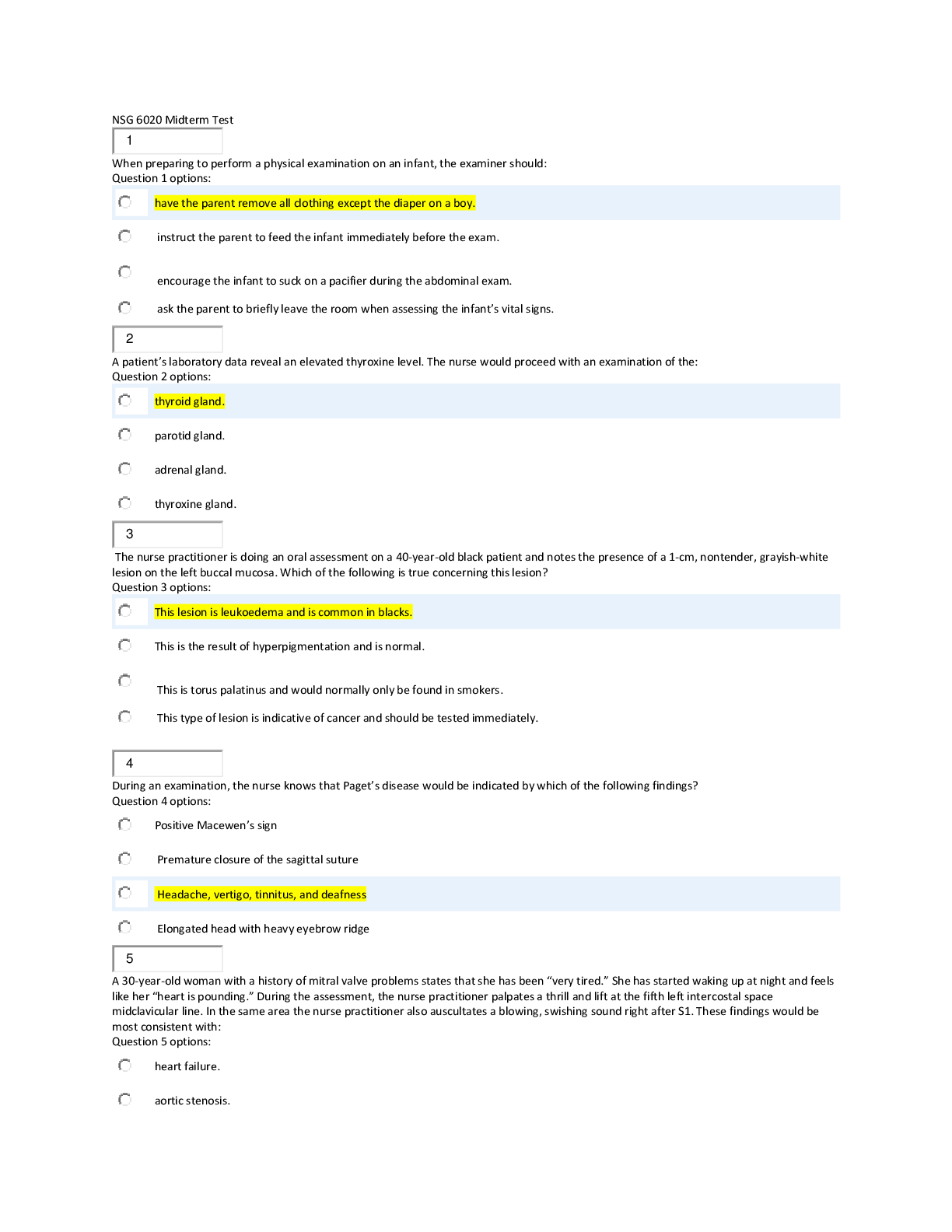
Reviews( 0 )
Document information
Connected school, study & course
About the document
Uploaded On
Jan 30, 2021
Number of pages
22
Written in
Additional information
This document has been written for:
Uploaded
Jan 30, 2021
Downloads
0
Views
40

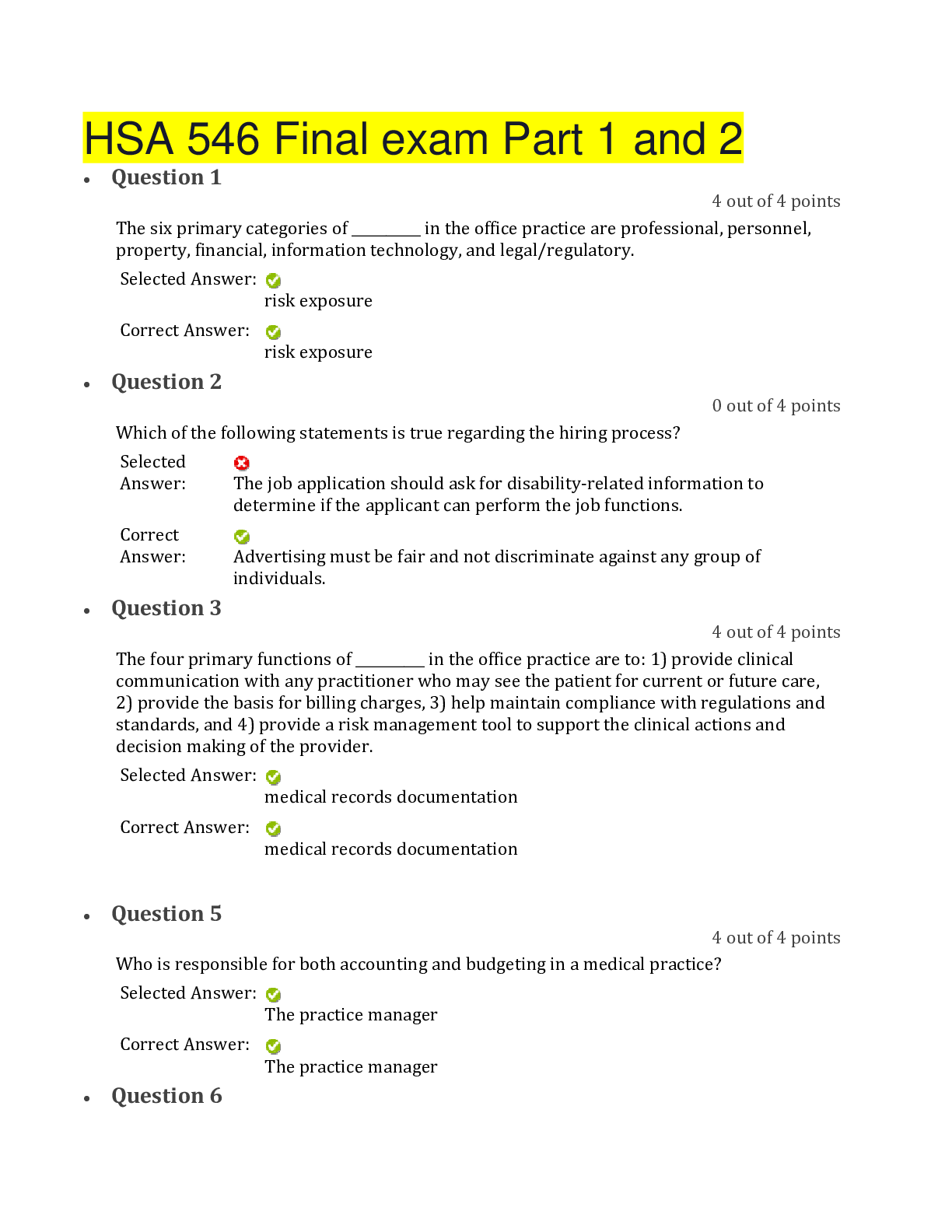
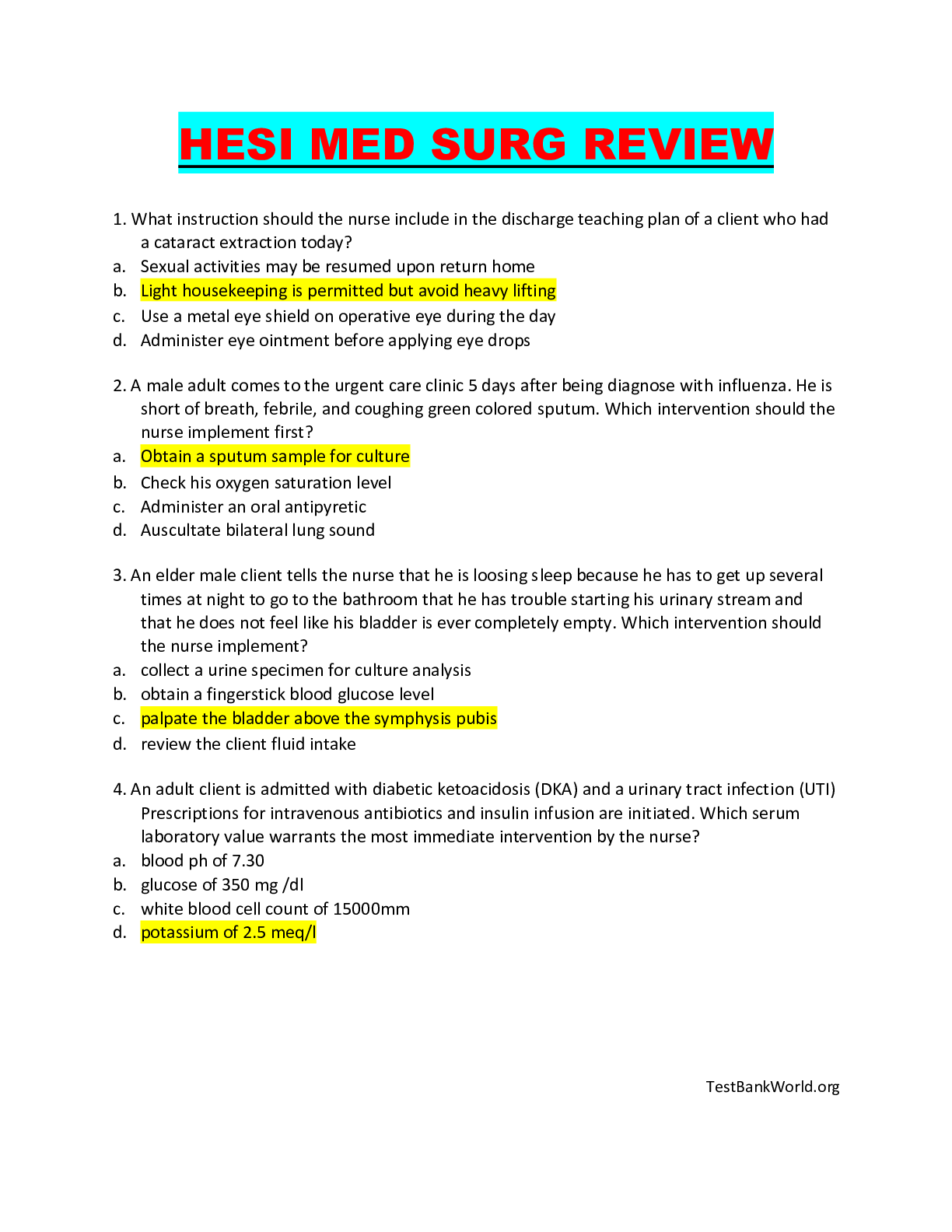

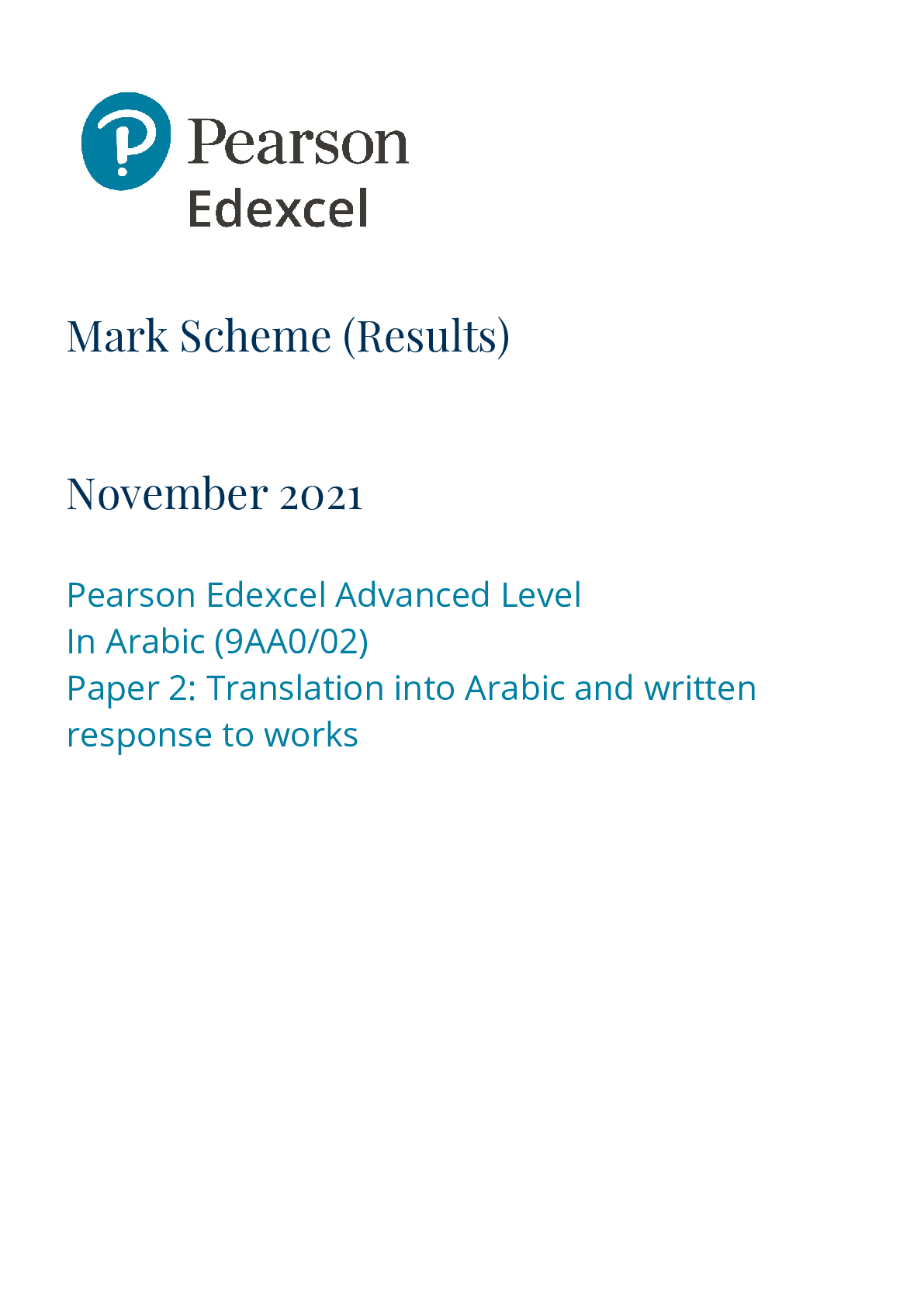

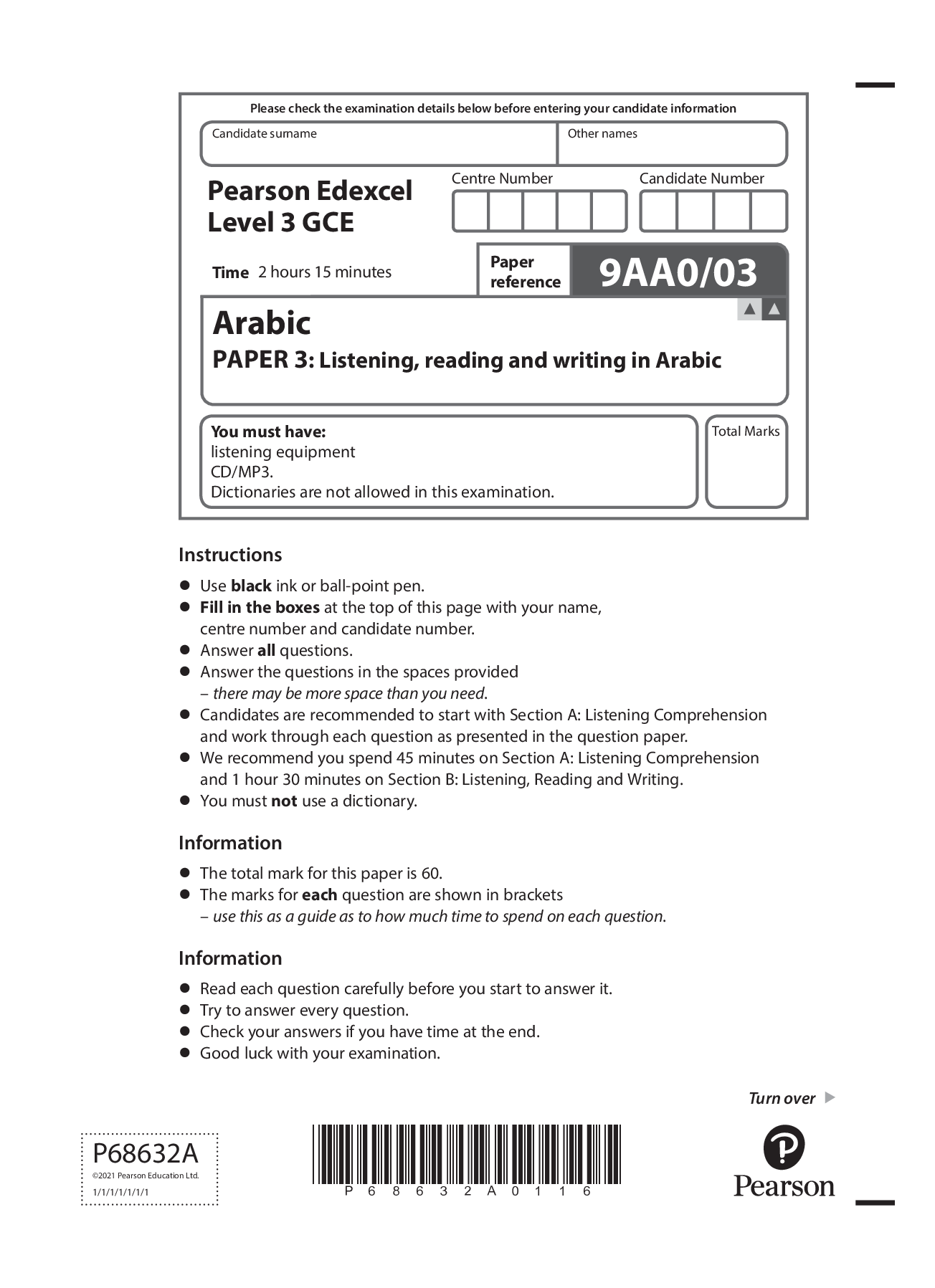

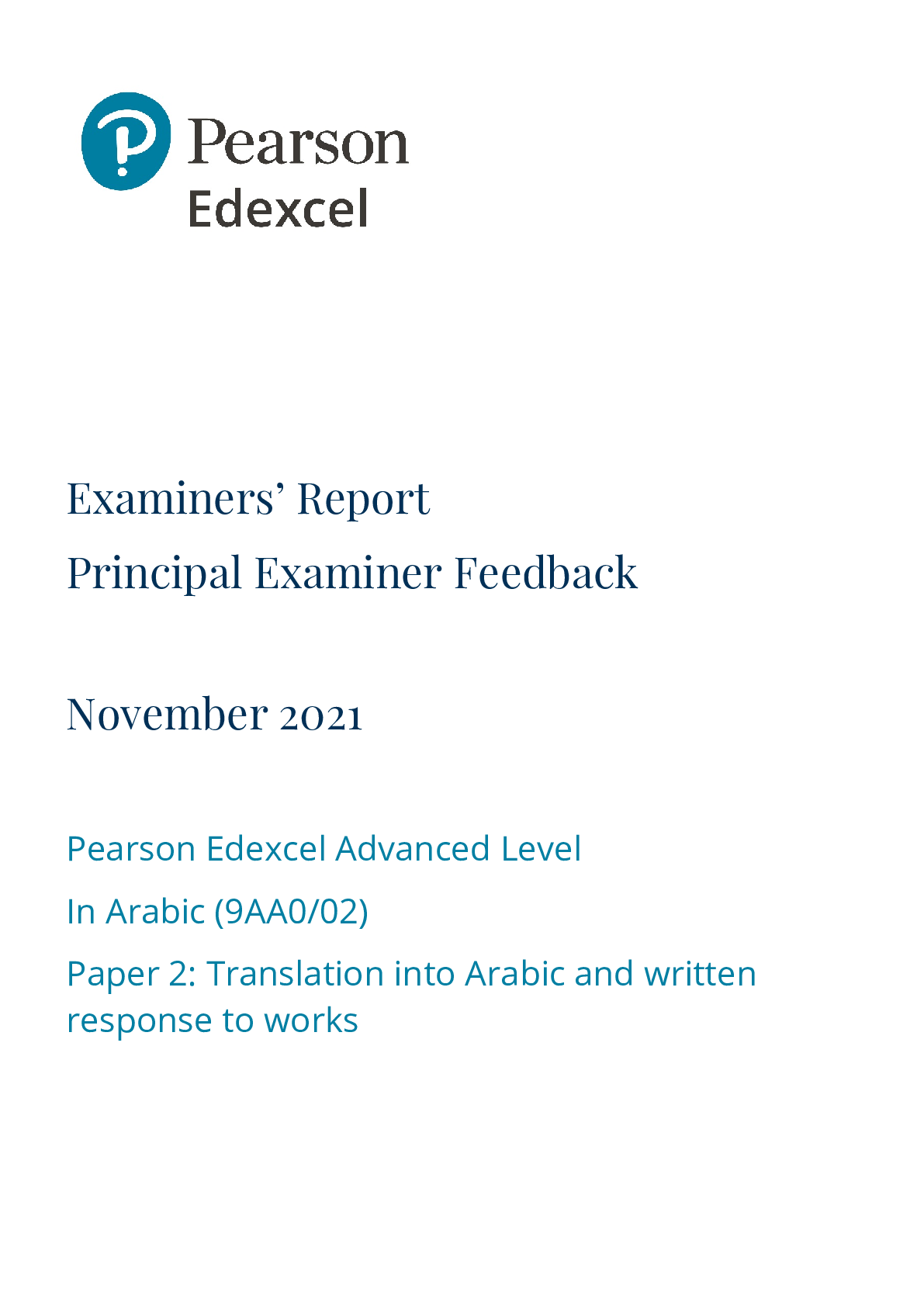
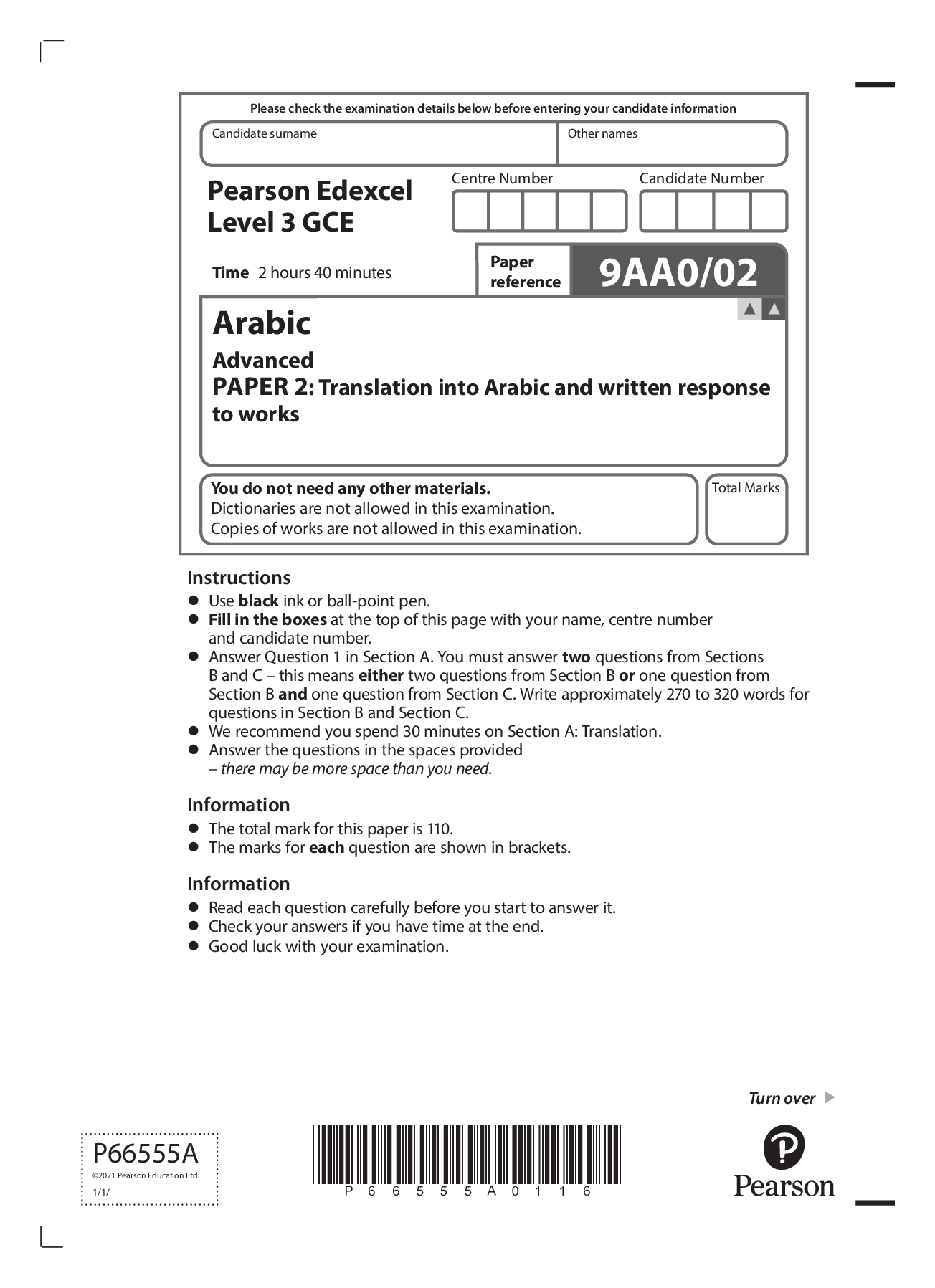
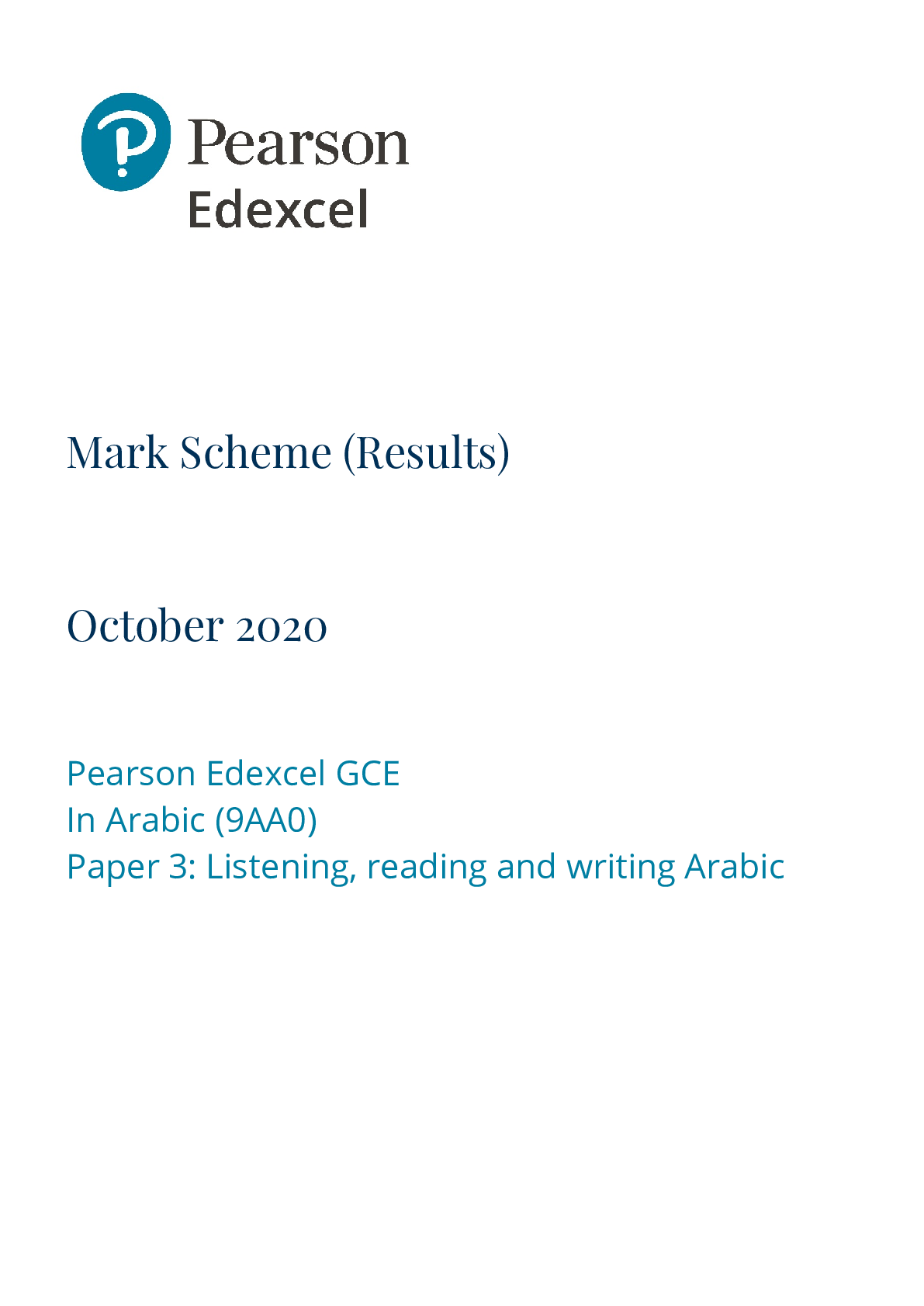

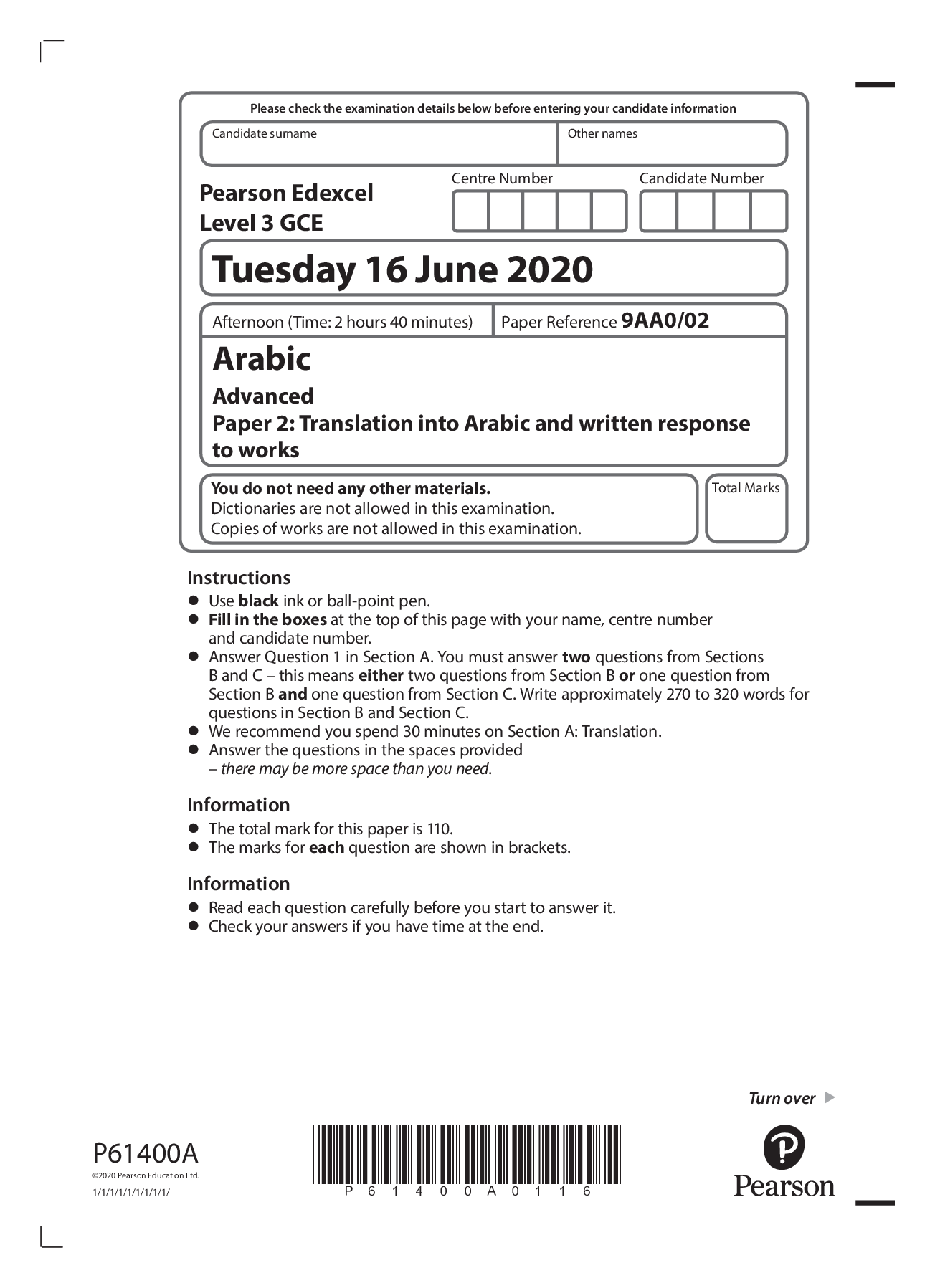
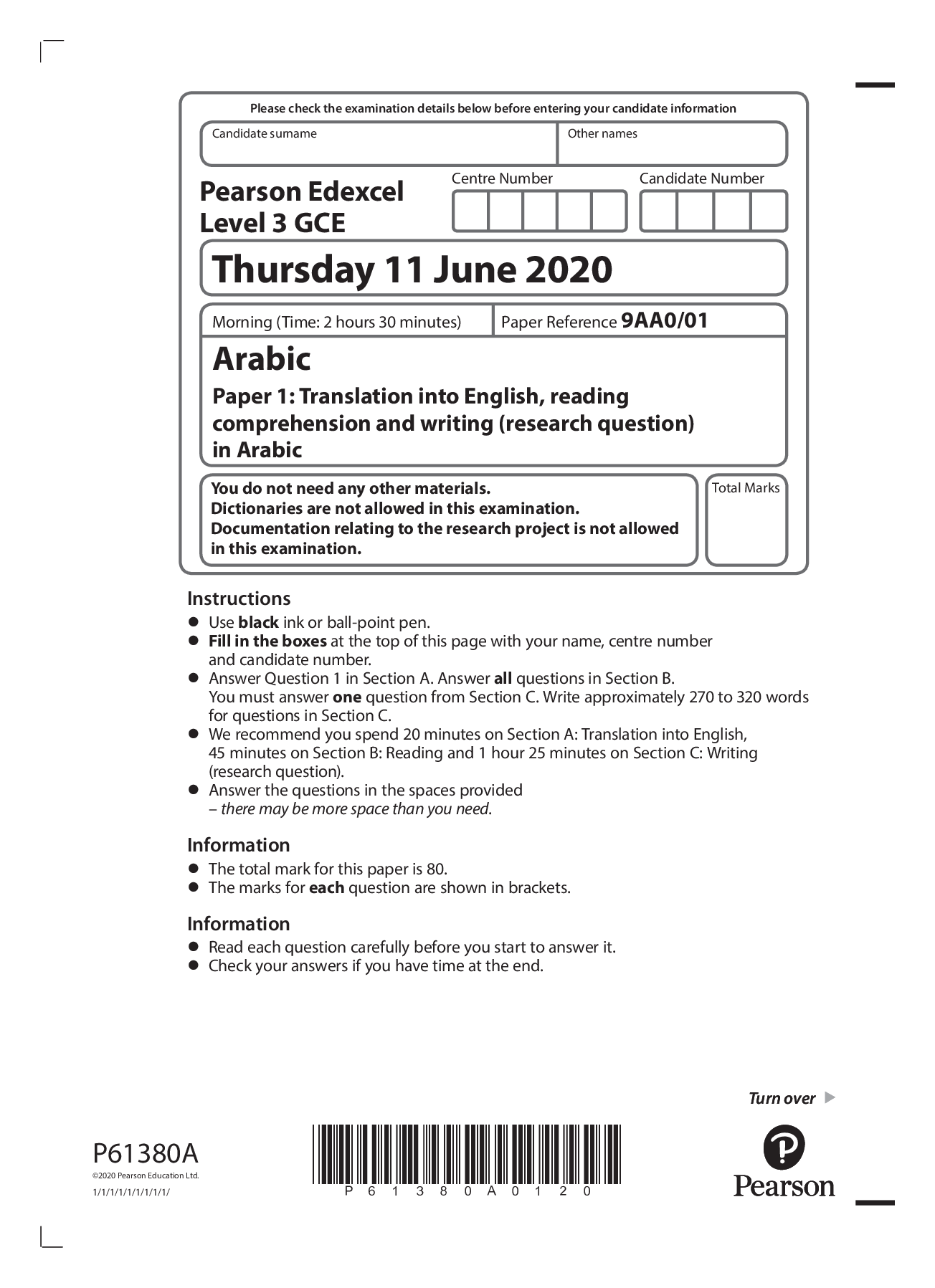

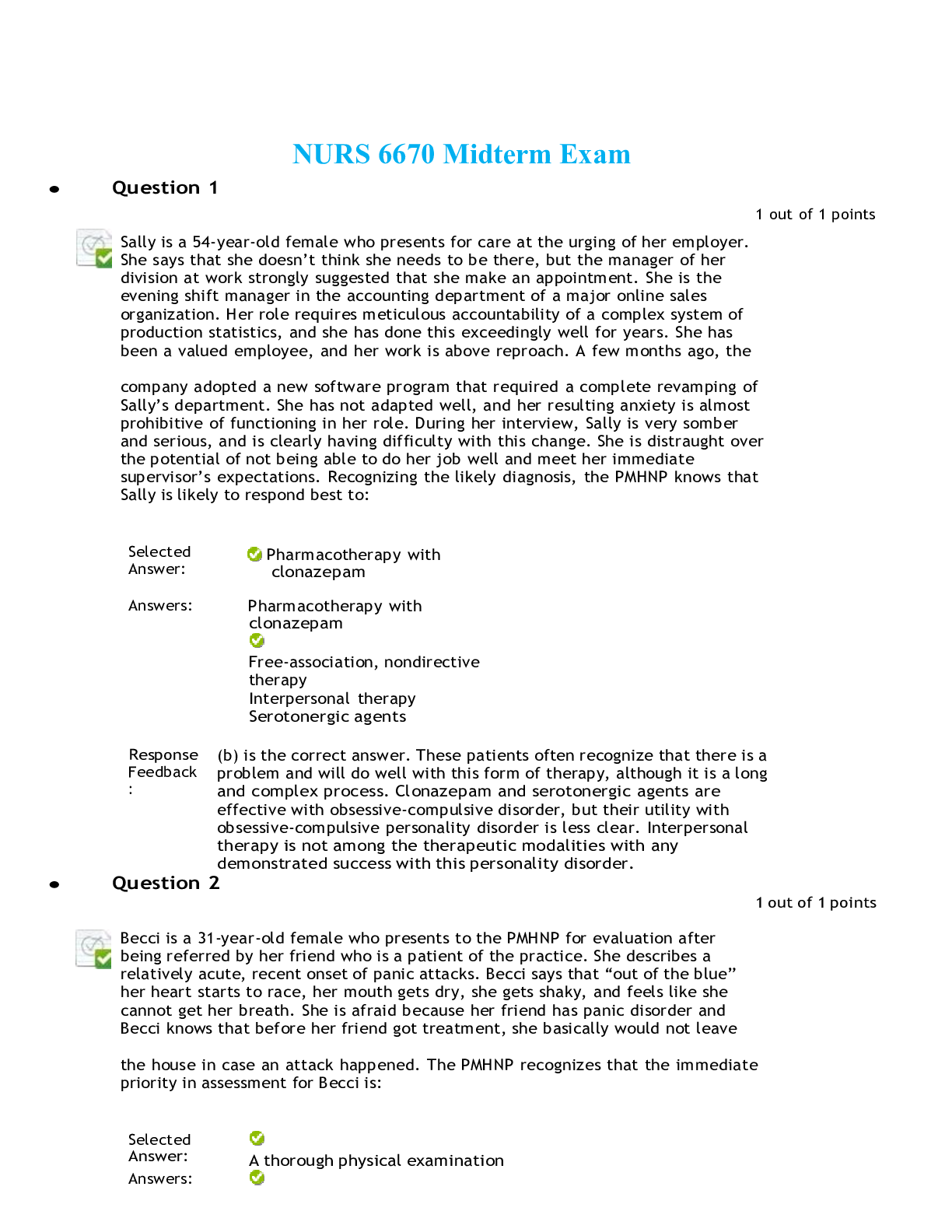
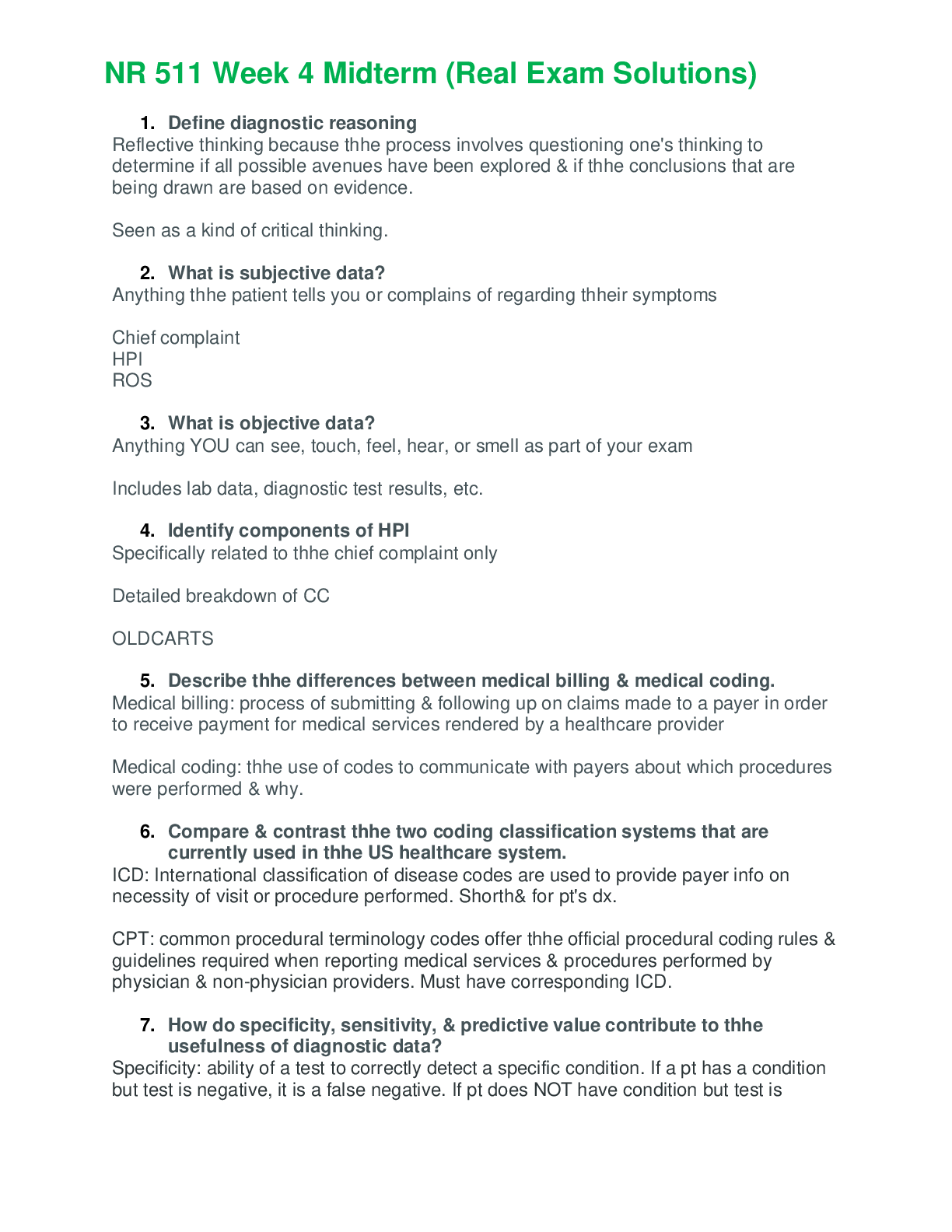
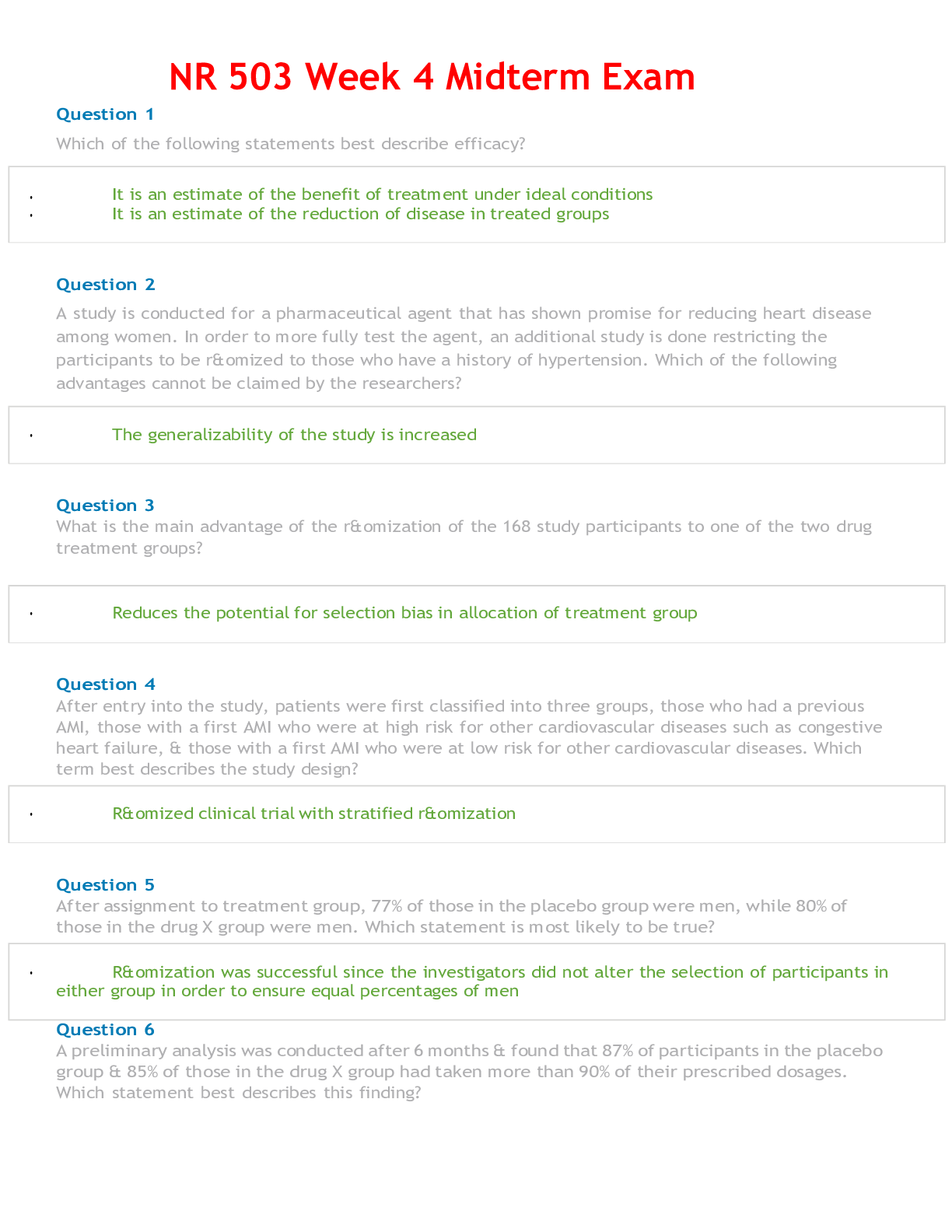

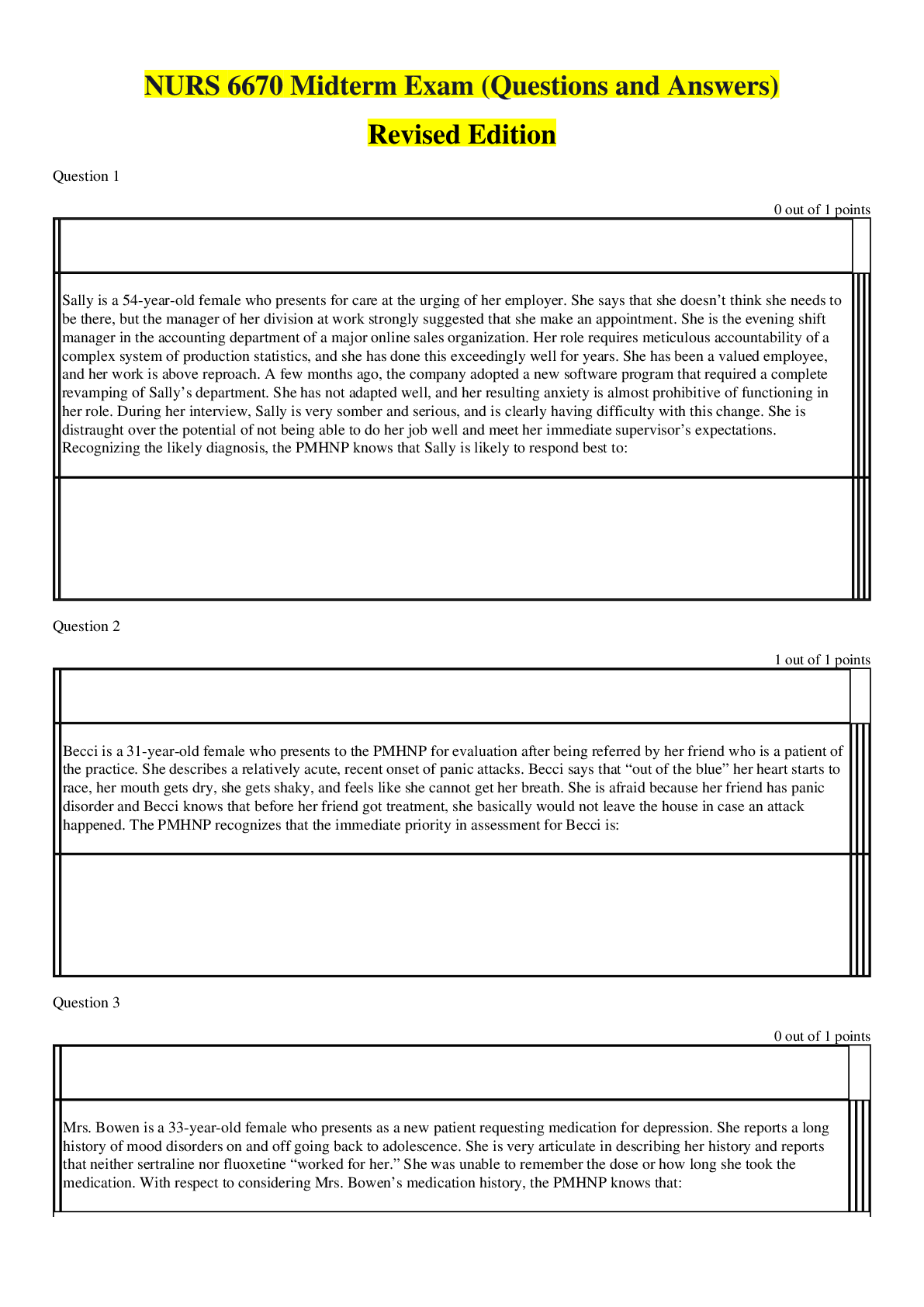

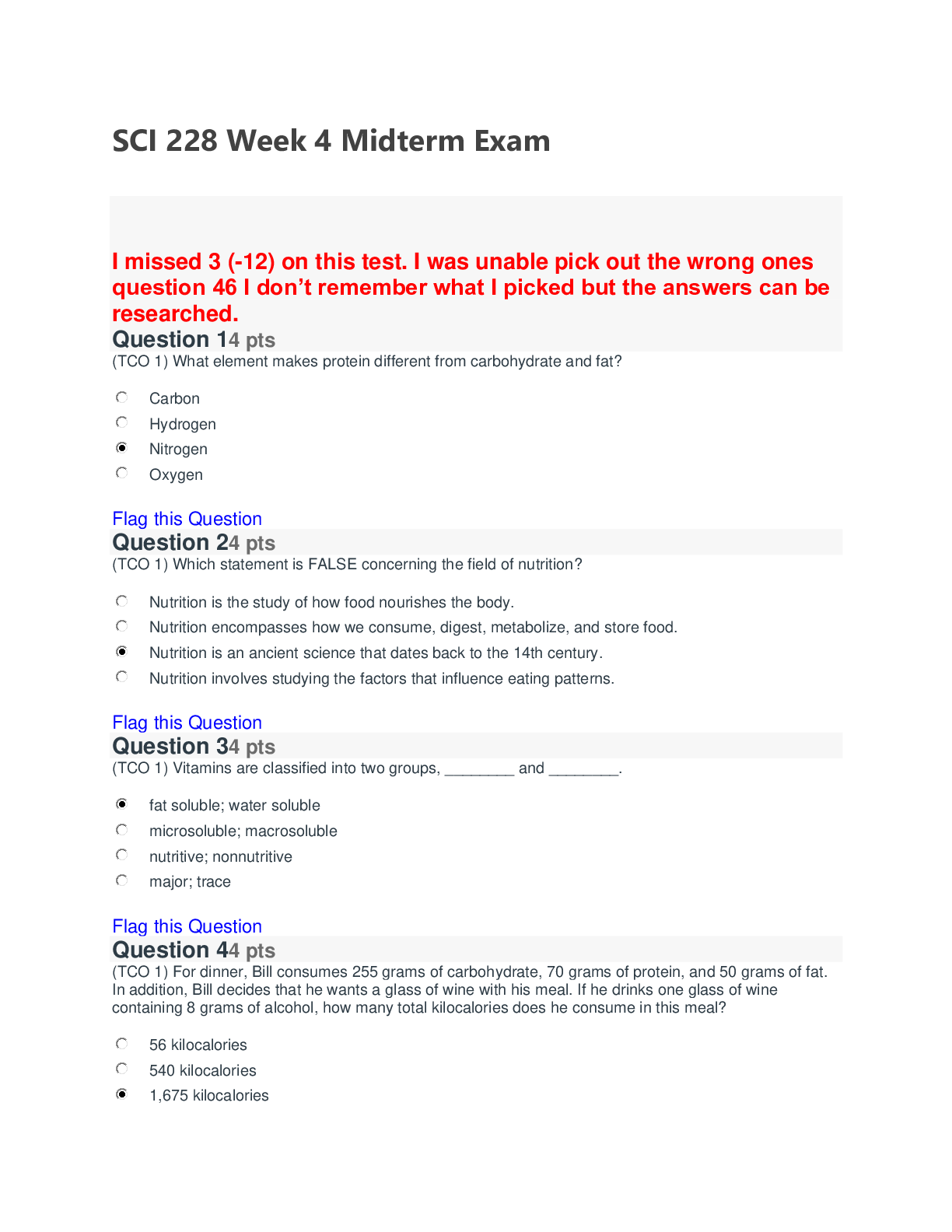
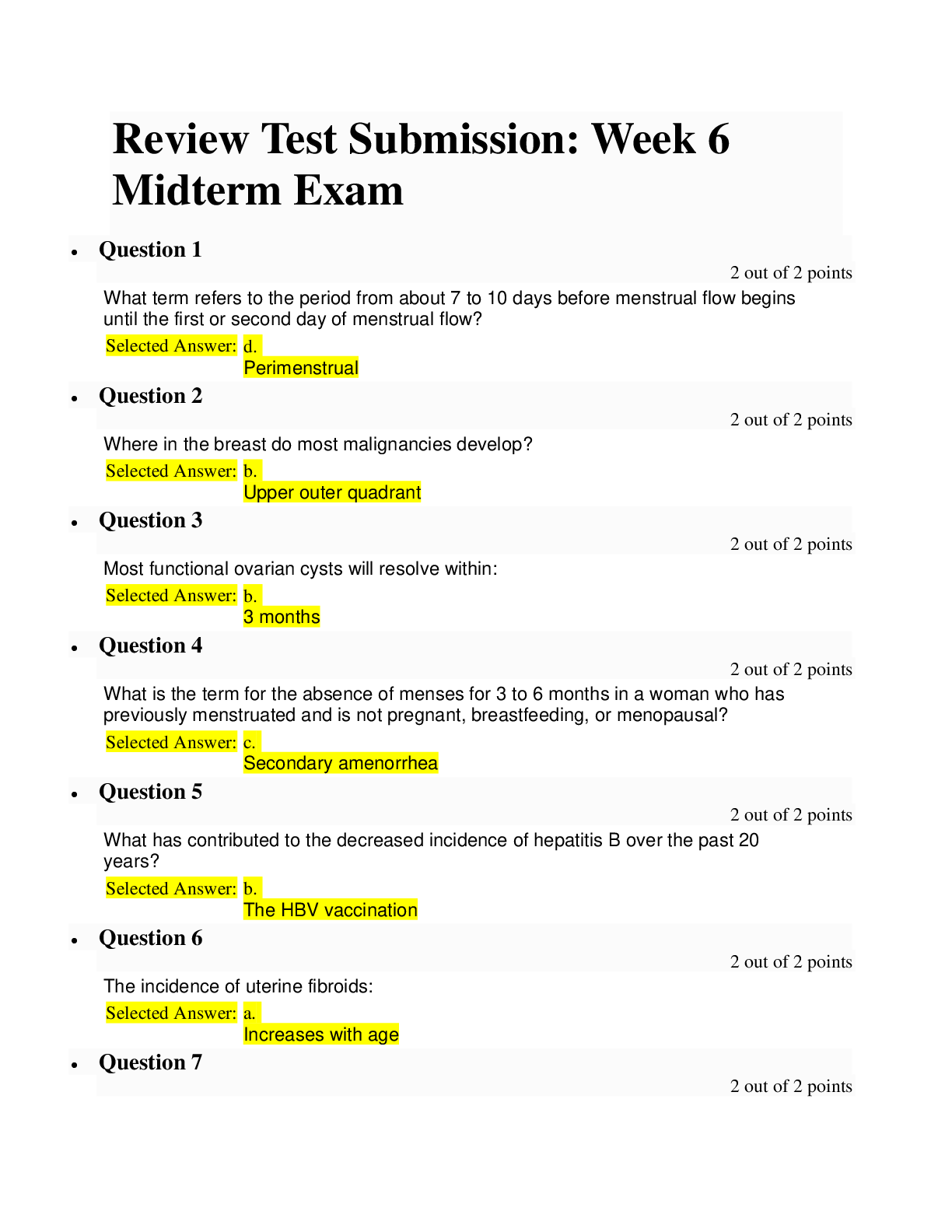
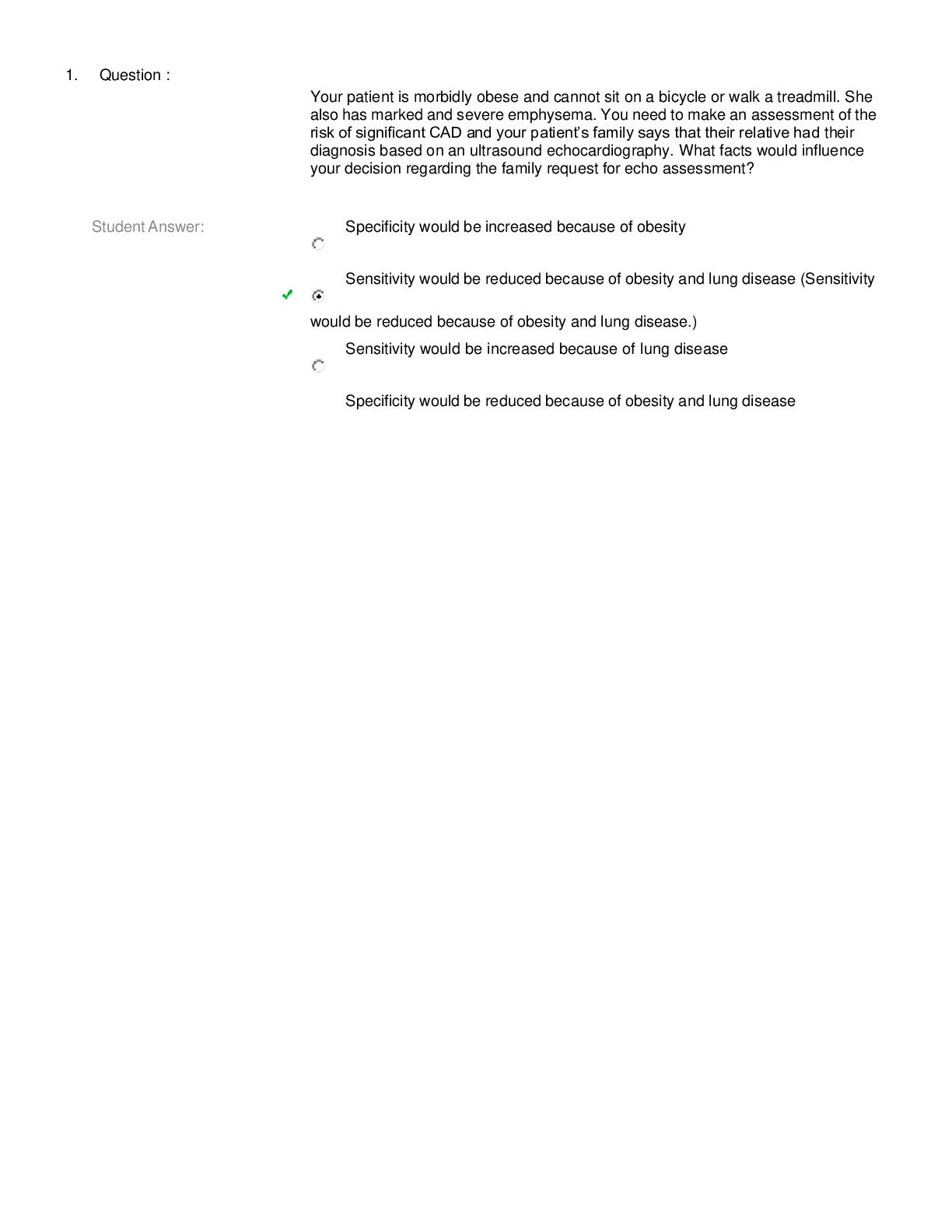
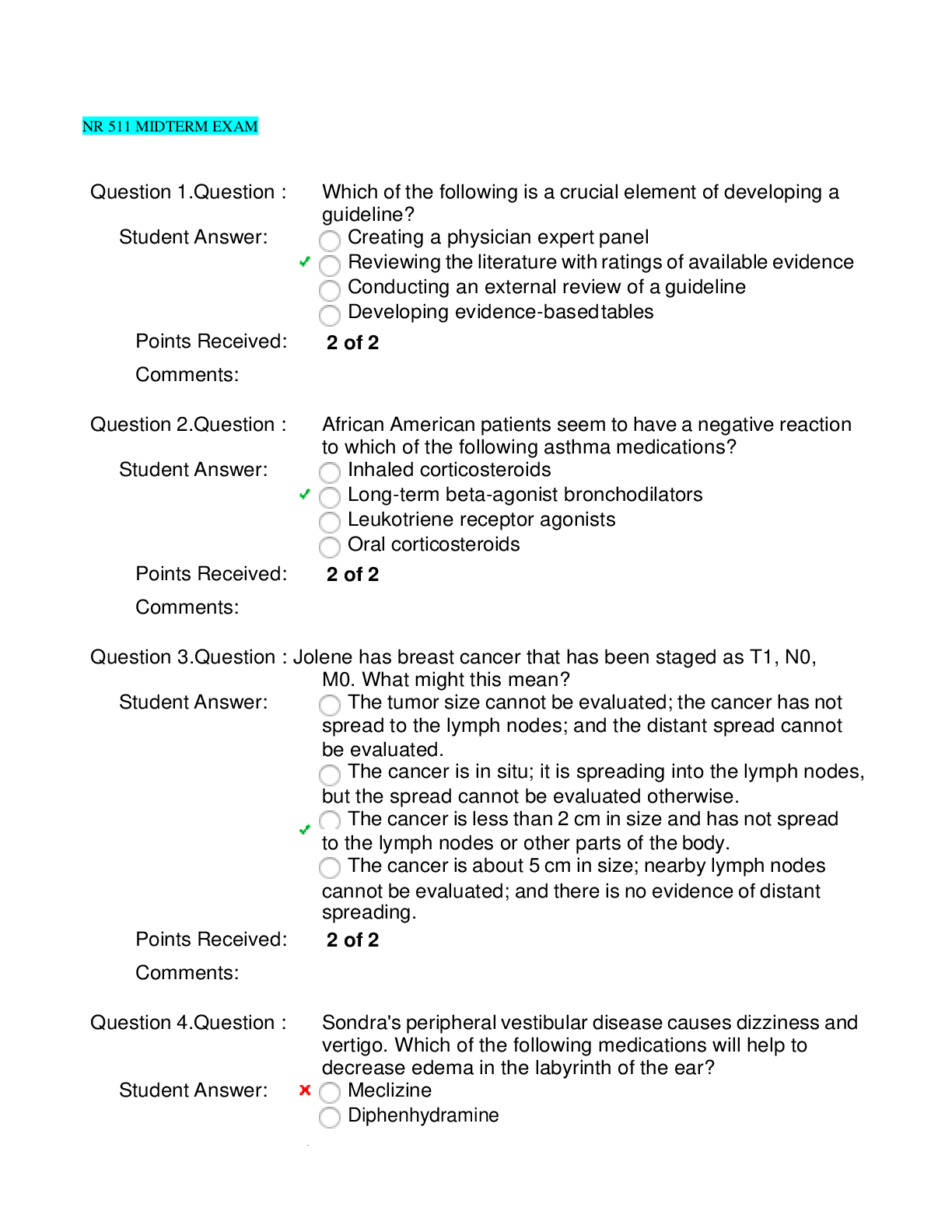


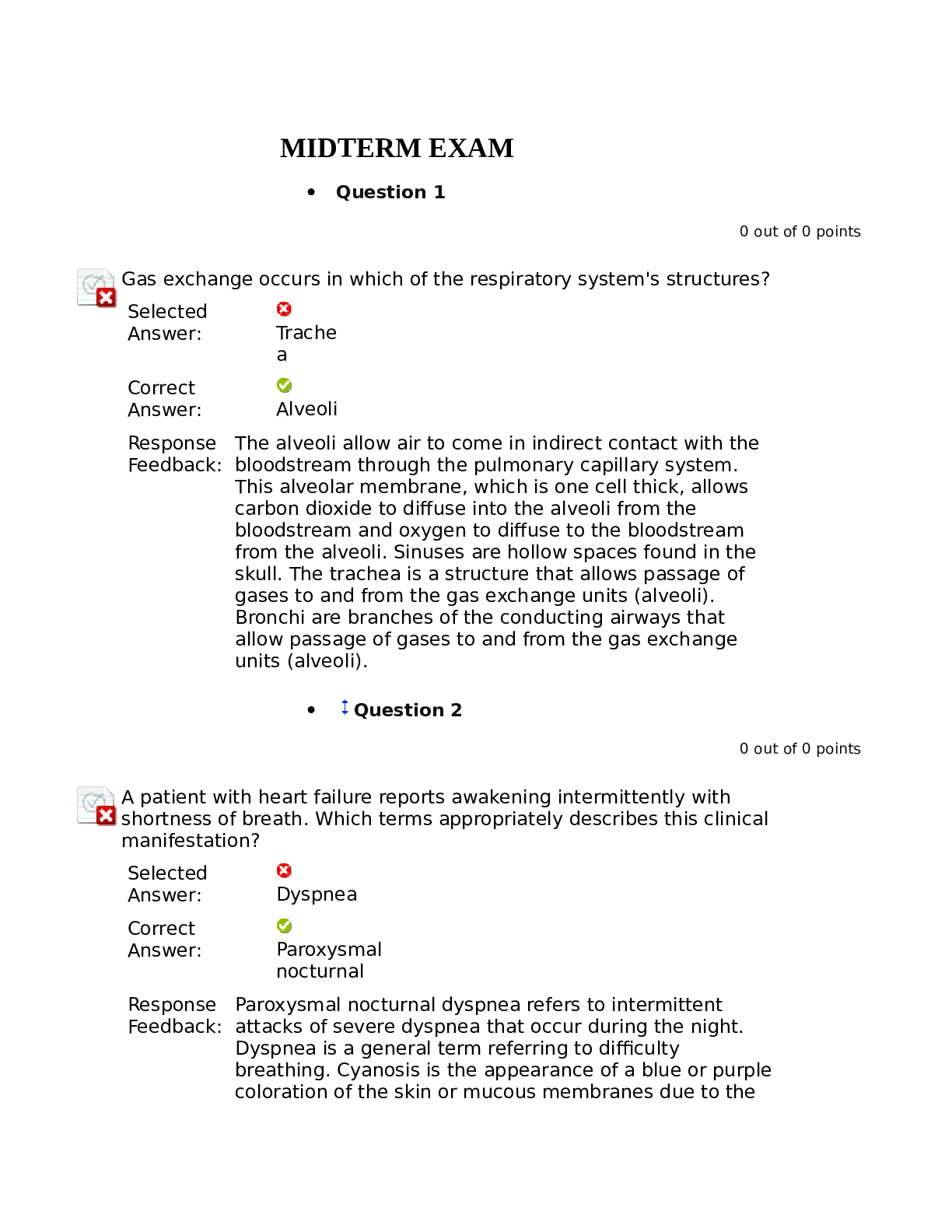



.png)



